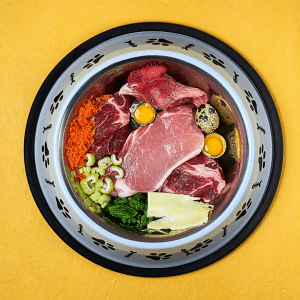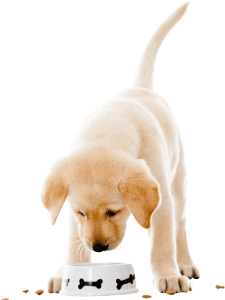
BARF diet has gained popularity among dog owners. It’s essential to make sure your pup’s diet is balanced and meets nutritional requirements so it’s advised to work with a veterinary nutritionist.
A raw food diet can be a healthy alternative for dogs.
But veterinary guidance is necessary to ensure your pup receives all the nutrients he needs.
I’m a former vet tech with experience feeding whole-food-based diets. And I’ve seen first hand the potential benefits of this unique method.
Before transitioning to a raw diet, dog owners need to consider the potential risks.
These diets only work when carefully formulated.
So keep reading to learn how to make the best diet for your four-legged friend.
What is a Raw Diet?
The foundation of a raw food diet for dogs is whole-food meals and limited processing.
Raw diet supporters believe a raw diet is a healthy alternative to kibble. They view raw meat as the optimal food for canine digestion.
Staples of a raw diet for dogs include uncooked muscle meat, organ meats such as liver and kidneys, whole bones, raw eggs, vegetables, and fruits.
The approach avoids feeding dogs processed ingredients found in cooked dog food.
Although this method has existed for decades, it is now a hot topic in the dog nutrition industry.
Raw Diet History
Traditional raw diet use is widespread for racing greyhounds and sled dogs. Now, the nutrition method has gained popularity in pet households.
And today, the raw food diet is a controversial subject.
This diet came to the international forefront under Australian veterinarian Ian Billinghurst in 1993. He introduced “Biologically Appropriate Raw Food,” appealingly known as BARF, to the world.
This acronym also stands for “Bones and Raw Food.”
BARF claimed that dogs should eat food that resembled their ancestor’s diet.
The Debate Over Raw Food
Proponents of raw food diets also argue that commercial food hinders canine wellbeing.
Processing food reduces nutrient density and can increase the risk of harmful contamination. Raw food supporters liken some commercial dog kibble to a canine version of fast food.
It is important to note that the AVMA (American Veterinary Medical Association) discourages owners from feeding their pets raw meat. [1]
Opponents of this diet believe that feeding dogs raw food increases the risk of diseases. It is also tricky to correctly balance your dog’s nutrition when developing a raw diet on your own.
Pet parents consider feeding raw food for a variety of reasons.
Some people believe their dogs should eat a diet like their ancestors. Others believe that their pet’s health will improve from the approach. While a few may harbor concerns about the quality of commercial dog food.
Although a complicated approach to dog nutrition, raw diets do provide certain benefits.
Benefits of Raw Diet
Owners believe the raw diet approach will transform their pets inside and out.
The potential benefits of a raw food diet include:
- Healthy skin
- Shiny coats
- Higher energy levels
- Better dental health
- Improved digestion
Healthy Skin and Coat
The most obvious benefit of a raw food diet is your dog’s skin and coat‘s external transformation.
Many canine skin conditions result from inflammation or allergies. Unfortunately, some ingredients in commercial dog food can promote inflammation. [2] Other components are common allergens.
How your dog looks on the outside reflects how he feels on the inside. The greater availability of nutrients in a whole food diet can boost health, so your dog looks as good as he feels.
When dogs suffer from nutritional deficiencies, their bodies focus on essential systems. If they do not have enough nutrients to support their entire body, their hair and skin suffer.
Higher Energy Levels
Raw diets usually offer more protein and less carbohydrates than commercial dog foods. The surge of sugar from kibble energizes your pup short term. But after the sugar high, your dog will feel tired and lethargic.
Raw diets do not contain added sugars. They can help stabilize energy levels in dogs and provide a healthy source of protein.
There is a good reason working dogs have benefitted from raw food diets for decades.
Better Dental Health
The lower sugar levels in a raw food diet also help improve dental hygiene.
Just like us, overeating candy and fast food can wreak havoc on our teeth. Whole food diets result in happier mouths and better breath. And chewing on bones included in the diet helps clean teeth.
You can’t give your dog a breath mint, but this diet just might do the trick for that stinky smile.
Improved Digestion
Improved digestion is another benefit of feeding your dog a raw food diet.
Some commercial food can make dogs gassy or uncomfortable because of irritating additives. Raw food diets do not include additives or preservatives. The only thing your dog eats is real food.
Using everything he consumes also reduces the size of the stool your dog produces.
As the owner of a massive dog with a small backyard, I see the appeal.
Potential Risks of Raw Diet
Despite potential benefits, the controversy surrounding raw food diets is well-founded.
There are considerable risks involved with feeding your dog with this approach. Severe consequences can result from formulating a diet like this without veterinary guidance.
Unbalanced Nutrition
When you buy commercial dog food from the pet store, you can read the label for valuable information. This information will tell you exactly how much of each nutrient the food provides. You can also often find feeding instructions included on a bag of kibble.
Commercial dog foods developed by nutritionists provide the ultimate convenience for owners. You can easily feed your pets a balanced diet that meets nutritional requirements.
Meanwhile, dog owners have to put together their dog’s raw food meals themselves. Meats, vegetables, and fruit don’t come with a full guaranteed analysis.
Without guidance, you can quickly create an unbalanced diet. Nutrient deficiencies caused by inappropriate diets can cause chronic problems, especially during growth. [3]
In the wild, wolves eat every part of a carcass to receive adequate nutrition. But it is difficult for owners to afford the variety and quality of ingredients their dogs need.
Risks for Puppies
It is very risky to feed growing puppies a raw diet. Young dogs depend on adequate levels of vitamins and minerals to develop correctly. If their diet is unbalanced, they can suffer from skeletal diseases.
Only consider a raw diet if your dog is an adult.
Bone Complications
Raw food diets often depend on bones to provide a source of calcium and phosphorus. But mineral availability depends on the dog’s ability to chew and digest the bone.
The digestive system dogs inherited from wolves can handle bones. But feeding bones comes with significant health risks.
Most dog owners fear the potential for bones to obstruct the esophagus and cause choke. [4] An accumulation of bone fragments in the colon can also lead to severe constipation.
Raw bones are safer than cooked bones because they do not splinter easily.
Bacteria Risks
A large part of the controversy surrounding raw diets involves the health risks of raw meat. All raw meat may contain illness-causing bacteria such as Salmonella and E.coli.
Commercially manufactured raw diet products are incredibly risky for cross-contamination.
These risks extend beyond dogs to humans in their household. Young, elderly, pregnant, and immunocompromised individuals are especially at risk when handling raw meat. [5]
The likelihood of bacteria causing your pet illness is small. But if they do get sick, prepare for sudden diarrhea.
Doggy diarrhea is never a highlight of pet ownership.
What Studies and Researchers Say About a Raw Diet For Dogs
The FDA conducted a two-year study to screen pet food samples for dangerous bacteria. The results of the study proved that raw pet food is much more likely to contain harmful microorganisms. [6]
Organizations like the AVMA now recommend against raw food diets for dogs based on the study. The risk of foodborne illnesses could pose a threat to public health.
Several studies confirm the concern over pet and human health when feeding raw diets. Scientific evidence shows that nearly all raw meat-based diets contain disease-causing bacteria. [6]
Other health risks observed in clinical studies involve nutritional deficiencies, toxicities, and hypothyroidism. [7]
Some studies show small increases in digestibility between raw and commercial diets. But other studies highlight the severe nutritional imbalances of an improper raw diet. [8]
Both commercial and homemade raw food diets had the same nutritional imbalances. Yet, cooked homemade diets did not present the same bacterial risks in the studies.
Most of the issues found by research arise from pet owners developing diets on their own. Like all canine food, raw diets need veterinary guidance for appropriate application.
The Appeal of Raw Diet for Dogs
Dog parents only want the best for their furry friends. But most of us are not well educated about canine nutrition.
Natural, whole-food options are healthiest for humans. So uneducated pet owners may assume raw diets are best for dogs.
After all, we all want to treat our pets like family.
Dog owners provide their pets with raw food diets to improve their health. But they don’t understand their dog’s nutritional needs.
If you want to feed your dog a raw food diet, you must do your research. Work with a veterinary nutritionist to develop a balanced diet for your dog. And learn how to handle raw meat safely.
Safer Alternative to Raw Diet
Thankfully, there are safer alternatives for pet parents who want their dogs to eat the best diet.
You can limit bacterial exposure by feeding cooked meats. This approach offers a handmade diet of whole food while limiting contamination.
Still, all handmade diet plans for dogs involve significant effort and need veterinary guidance.
Pet parents interested in healthier alternatives can also consider commercial fresh foods. Expert nutritionists develop these formulas. But they do not include the same processed ingredients as some kibble.
How to Start Your Dog on a Raw Diet
First, consult with your veterinarian about the implications of changing your dog’s diet.
You should develop a program that provides your dog with everything he needs to thrive.
After coming up with an appropriate plan, you need to transition your dog to the raw diet.
This transition is an integral part of the process. Your dog’s health can suffer if you do not transition your dog correctly.

Slow and steady wins the race. Raw food diets are very different from commercial food. Your dog will need some time to get used to his new dinner.
A slow transition is essential for gastrointestinal health. Your dog’s digestive system has to acclimate to digesting raw food. If you transition abruptly, your pup may suffer from an upset stomach.
Pets may also be picky about food texture and appearance. They may not even try new and different food.
Mixing the new food with old kibble will help ease the transition. Simply add a progressively higher part of raw food over an extended period.
Eventually, your dog will transition seamlessly to a 100% raw meal.
Check our 10 best raw dog food options.
Essential Tips for Starting a Raw Food Diet
Here are some tips to help you start your dog on a healthy raw food diet.
Include Sources of Calcium
Calcium and phosphorus are two of the most critical minerals dogs get from their diet. They are also frequently deficient in poorly designed raw food diets.
Minerals are especially critical for growing puppies. Without appropriate amounts of calcium, dogs cannot develop a healthy skeleton.
Meat is high in phosphorus but low in calcium. And an all-meat diet can cause nervous system issues in your dog.
Bones are an excellent source of calcium. If you feed a whole food diet, find out the safest way to feed bones to your dog to keep his diet balanced.
Safe options for raw diets include raw chicken, turkey, lamb, and beef bones. Do not feed your dog cooked bones, as they can splinter and puncture his gut.
Provide a Vitamin and Mineral Supplement
Supplementation is the simplest way to limit nutritional gaps in a raw diet.
When I feed whole food diets to my pets, I always include a vitamin and mineral supplement. Quality supplements feature a guaranteed analysis, unlike raw food.
The best option for your dog will meet his nutrient requirements. Work with your veterinarian to determine if your pup needs supplementation to balance his diet.
Variety Is Vital
Just like humans, dogs need a variety of foods to thrive. Feeding diverse types of food to your dog provides him with unique nutrient sources.
Meat is the basis of most canine raw diets. Offer a variety of meat to broaden the nutrients provided by the diet. Chicken is a healthy lean meat, while beef is rich in iron.
Organs are also excellent sources of vitamins and minerals. Include a variety of organs in your dog’s diet to boost nutritional content. Healthy options include liver, heart, and kidney meat.
Different foods have different nutrient profiles. Offering a wide range of meat, fruits, and vegetables can help provide overall nutrition.
Only feeding one type of food to your dog will cause imbalances. A variety of ingredients is key to overcoming the potential shortfalls of raw diets.
The Bottom Line
A raw food diet can help improve your dog’s health.
But, this nutritional approach involves significant risks to pets and humans. To develop a healthy homemade diet for your pup, work with a veterinary nutritionist.
Learn more about whole-food ingredients to improve your dog’s diet by reading this list of human food dogs can eat.

